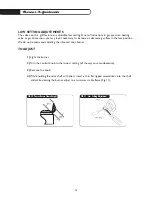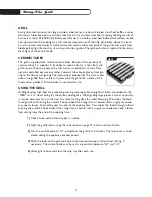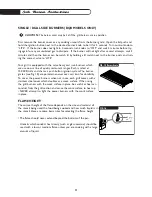
Gas Requirements
10
LP TANK REQUIREMENTS:
WARNING:
A dented or rusty LP tank may be hazardous and should be checked by your LP supplier.
Never use a cylinder with a damaged valve. Always check for leaks after every LP tank
change.
The LP gas cylinder must be constructed and marked in accordance with the specifications for LP gas
cylinders of the U.S. Department of Transportation (DOT) and designed for use with a Type 1 system
only. Do not change the regulator/hose assembly from that supplied with the unit or attempt to use a
5LP-A equipped regulator/hose assembly with a standard 510 POL tank/valve assembly. The cylinder
must be provided with a shut off valve terminating in an LP gas supply cylinder valve outlet specified, as
applicable, for connection Type 1.
NOTE:
If the appliance is stored indoors the cylinder must be disconnected and removed from the
appliance. Cylinders must be stored outdoors in a well-ventilated area out of the reach of
children.
LOCATION:
When determining a suitable location take into account concerns such as exposure to wind, proximity
to traffic paths and keeping any gas or electrical supply lines as short as possible. Locate the grill only in
a well ventilated area. Never locate the grill in a building, garage, breezeway, shed or other such
enclosed areas without an approved ventilation system. During heavy use, the grill will produce a lot of
smoke. Ensure there is adequate area for it to dissipate.The transformer box should be mounted to a
back or side wall inside the enclosure at least 12” from the ground. A special connection cable is pre-
wired to the grill and will reach 48” from the left rear corner of the grill.This cable must not rest on
the surface of the grill or lay on the ground.Take up any extra cabling and secure it from movement.


























